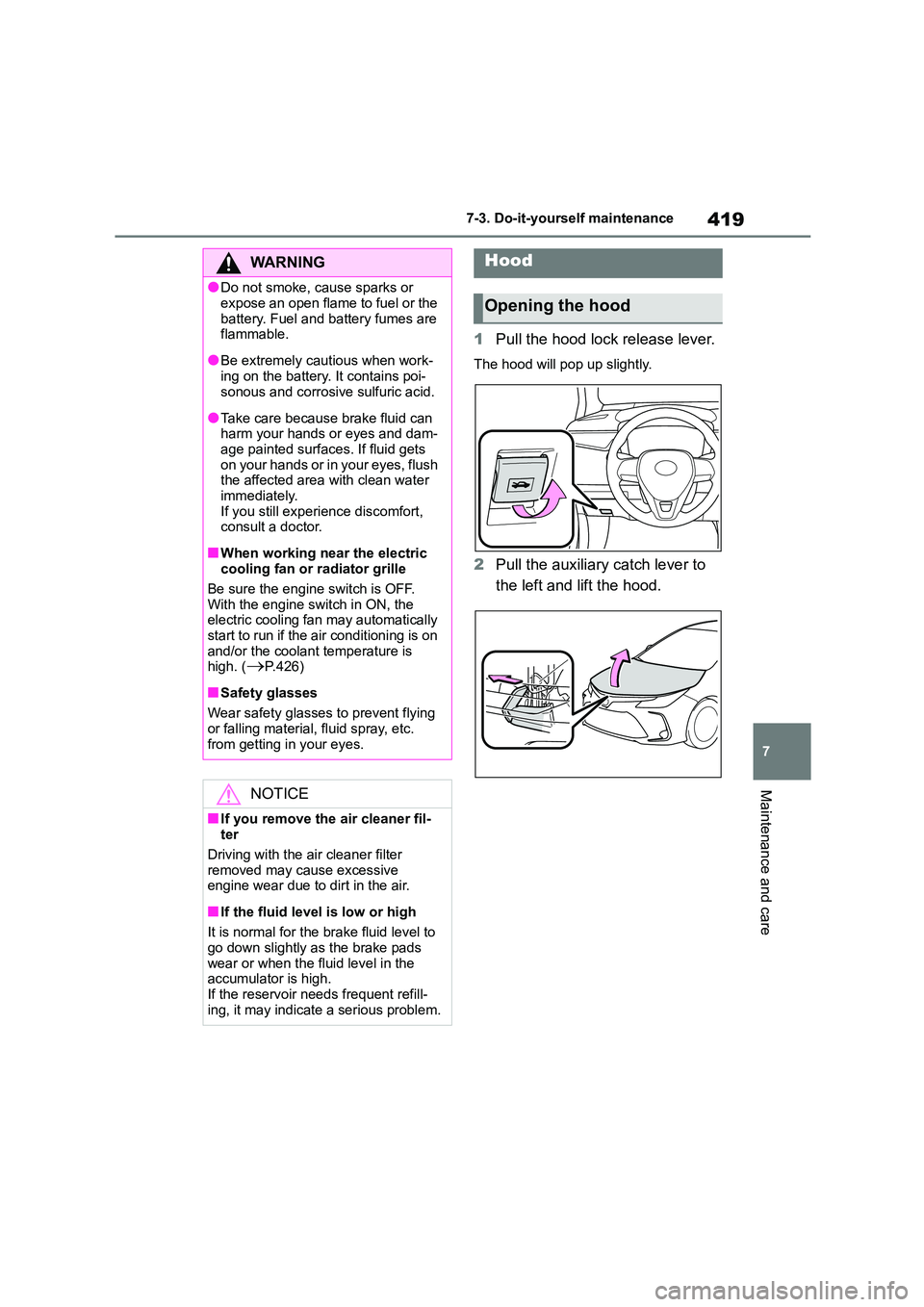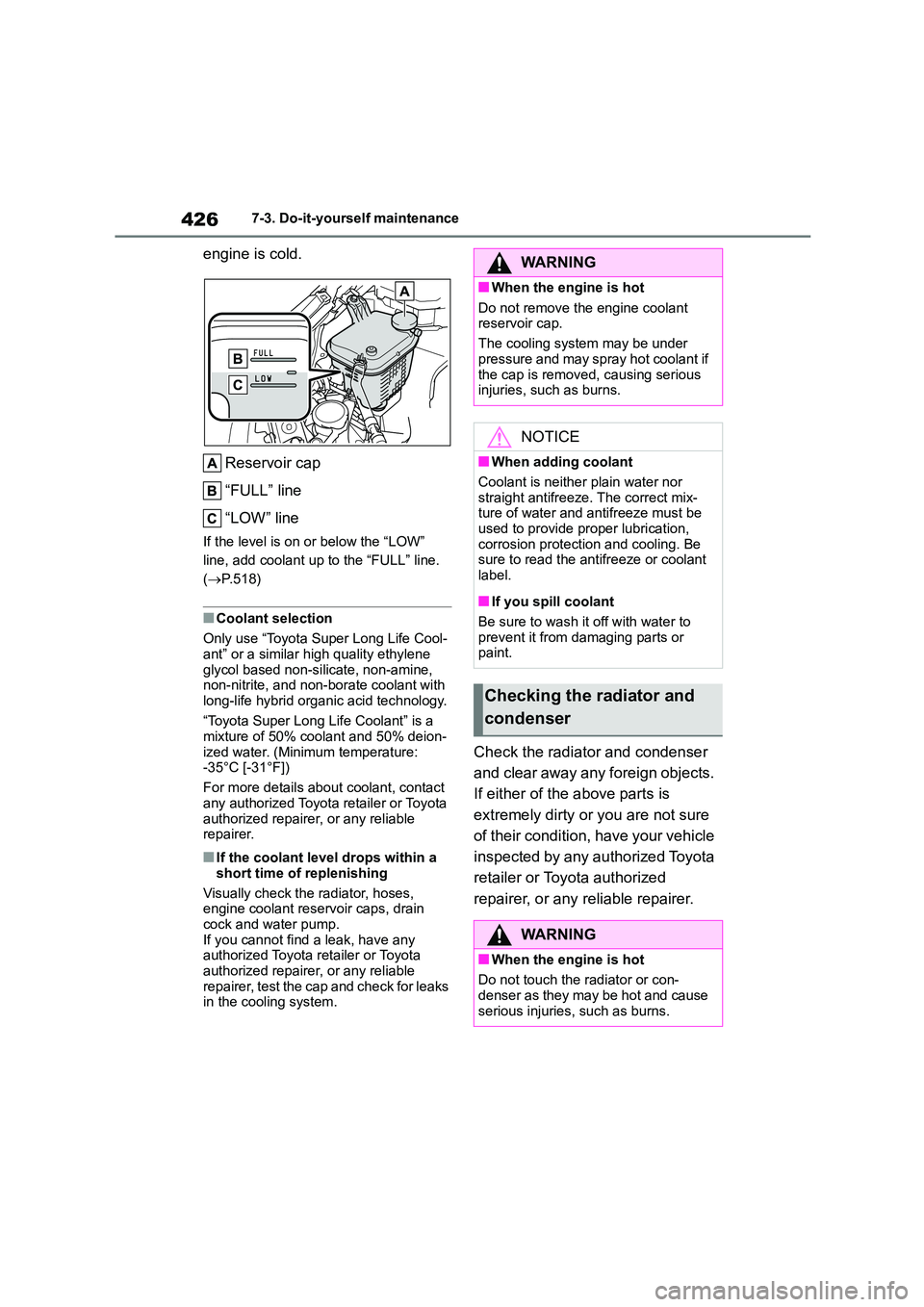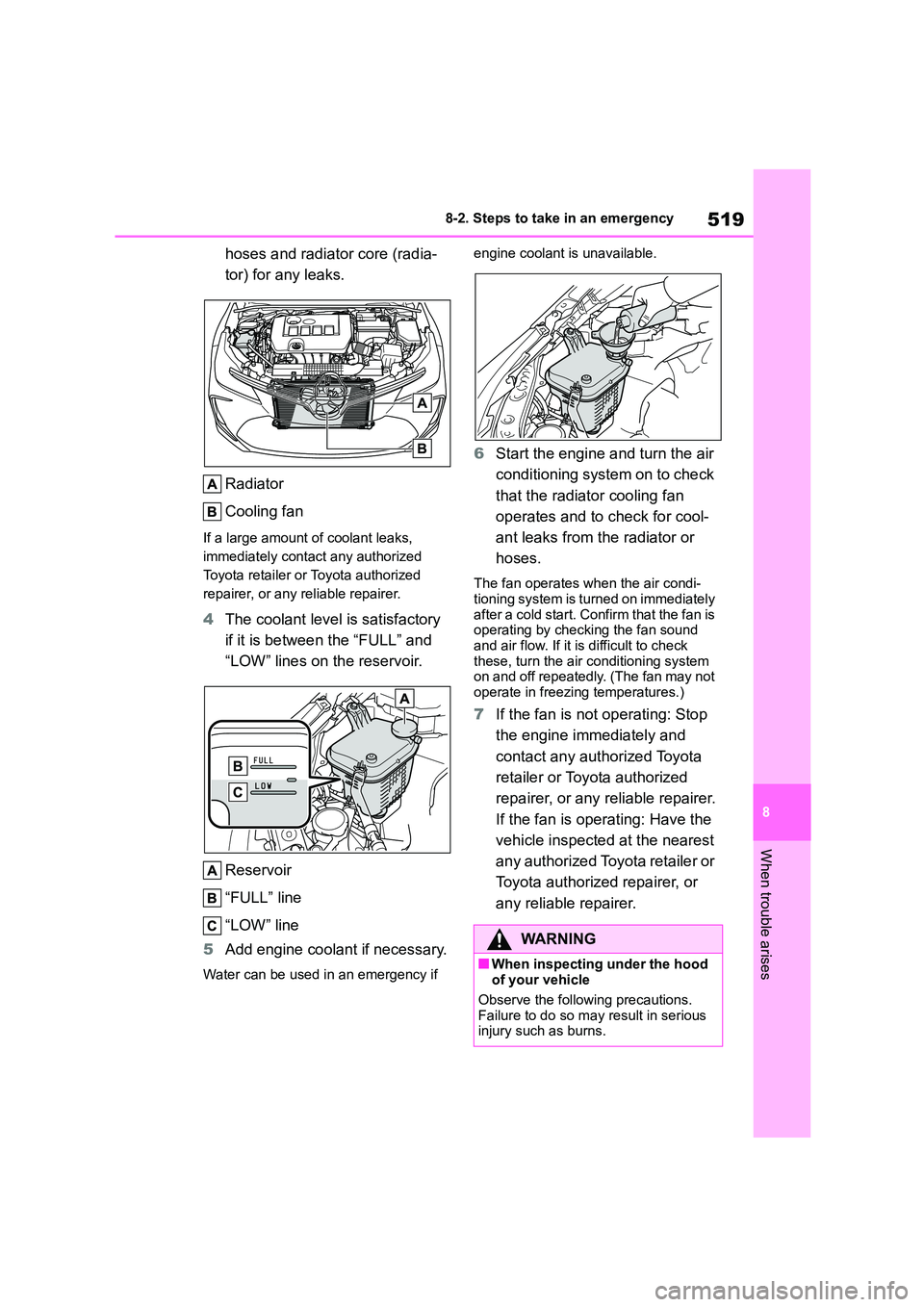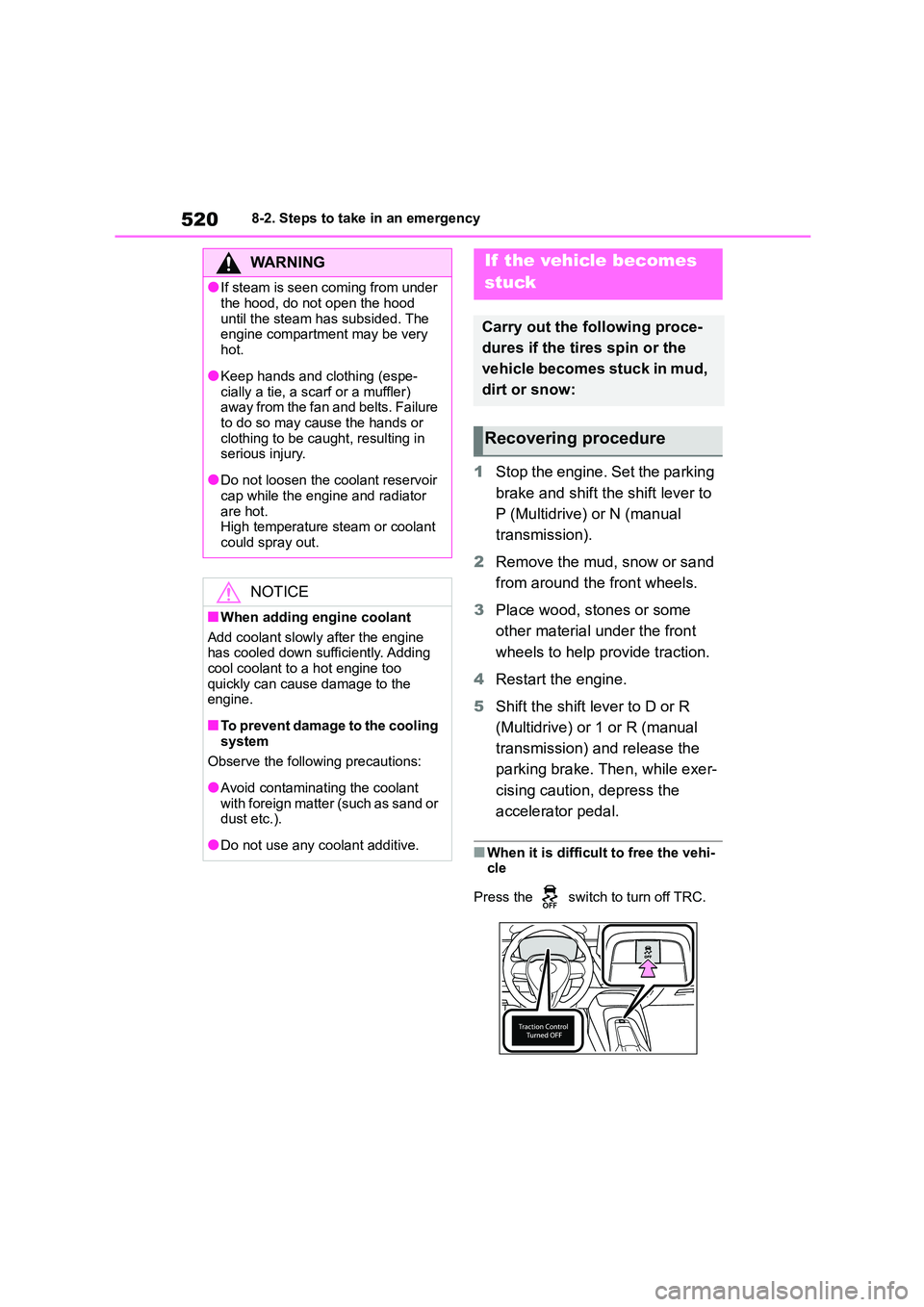2022 TOYOTA COROLLA radiator
[x] Cancel search: radiatorPage 420 of 678

4187-3. Do-it-yourself maintenance
7-3.Do-it-yourself maintenance
Do-it-yourself ser vice
precautions
If you perform maintenance by
yourself, be sure to follow the
correct procedure as given in
these sections.
Maintenance
ItemsParts and tools
Battery con-
dition
( P.427)
•Warm water
• Baking soda
• Grease
• Conventional wrench
(for terminal clamp
bolts)
Engine cool-
ant level
( P.425)
• “Toyota Super Long
Life Coolant” or a simi-
lar high quality ethyl-
ene glycol-based
non-silicate,
non-amine, non-nitrite
and non-borate cool-
ant with long-life
hybrid organic acid
technology
“Toyota Super Long
Life Coolant” is
pre-mixed with 50%
coolant and 50%
deionized water.
• Funnel (used only for
adding coolant)
Engine oil
level
( P.423)
• “Toyota Genuine Motor
Oil” or equivalent
• Rag or paper towel
• Funnel (used only for
adding engine oil)
Fuses
( P.452)
• Fuse with same
amperage rating as
original
Light bulbs
( P.455)
• Bulb with same num-
ber and wattage rating
as original
• Flathead screwdriver
• Wrench
Radiator and
condenser
( P.426)
Tire inflation
pressure
( P.444)
• Tire pressure gauge
• Compressed air
source
Washer fluid
( P.428)
• Water or washer fluid
containing antifreeze
(for winter use)
• Funnel (used only for
adding water or
washer fluid)
WA R N I N G
The engine compartment contains many mechanisms and fluids that
may move suddenly, become hot, or
become electrically energized. To avoid death or serious injury, observe
the following precautions.
■When working on the engine
compartment
●Keep hands, clothing and tools away from the moving fan and
engine drive belt.
●Be careful not to touch the engine,
radiator, exhaust manifold, etc. right
after driving as they may be hot. Oil and other fluids may also be hot.
●Do not leave anything that may burn easily, such as paper and
rags, in the engine compartment.
ItemsParts and tools
Page 421 of 678

419
7
7-3. Do-it-yourself maintenance
Maintenance and care
1 Pull the hood lock release lever.
The hood will pop up slightly.
2Pull the auxiliary catch lever to
the left and lift the hood.
WA R N I N G
●Do not smoke, cause sparks or
expose an open flame to fuel or the
battery. Fuel and battery fumes are flammable.
●Be extremely cautious when work-ing on the battery. It contains poi-
sonous and corrosive sulfuric acid.
●Take care because brake fluid can harm your hands or eyes and dam-
age painted surfaces. If fluid gets
on your hands or in your eyes, flush the affected area with clean water
immediately.
If you still experience discomfort, consult a doctor.
■When working near the electric cooling fan or radiator grille
Be sure the engine switch is OFF.
With the engine switch in ON, the electric cooling fan may automatically
start to run if the air conditioning is on
and/or the coolant temperature is high. (P.426)
■Safety glasses
Wear safety glasses to prevent flying
or falling material, fluid spray, etc.
from getting in your eyes.
NOTICE
■If you remove the air cleaner fil- ter
Driving with the air cleaner filter
removed may cause excessive engine wear due to dirt in the air.
■If the fluid level is low or high
It is normal for the brake fluid level to
go down slightly as the brake pads
wear or when the fluid level in the accumulator is high.
If the reservoir needs frequent refill-
ing, it may indicate a serious problem.
Hood
Opening the hood
Page 424 of 678

4227-3. Do-it-yourself maintenance
1ZR-FAE engine
Washer fluid tank ( P.428)
Engine coolant reservoir ( P. 4 2 5 )
Fuse boxes ( P.452)
Engine oil level dipstick ( P.423)
Engine oil filler cap ( P.424)
Battery ( P.427)
Radiator ( P.426)
Condenser ( P.426)
Electric cooling fan
Engine compartment
Components
Page 425 of 678

423
7
7-3. Do-it-yourself maintenance
Maintenance and care
M15A-FKS engine
Washer fluid tank ( P.428)
Engine coolant reservoir ( P. 4 2 5 )
Fuse boxes ( P.452)
Engine oil filler cap ( P.424)
Engine oil level dipstick ( P.423)
Battery ( P.427)
Radiator ( P.426)
Condenser ( P.426)
Electric cooling fan
With the engine at operating tem-
perature and turned off, check the
oil level on the dipstick.
■Checking the engine oil
1 Park the vehicle on level
ground. After warming up the
engine and turning it off, wait
more than 5 minutes for the oil
to drain back into the bottom of
the engine.
Checking and adding the
engine oil
Page 428 of 678

4267-3. Do-it-yourself maintenance
engine is cold.
Reservoir cap
“FULL” line
“LOW” line
If the level is on or below the “LOW”
line, add coolant up to the “FULL” line.
( P.518)
■Coolant selection
Only use “Toyota Super Long Life Cool-
ant” or a similar high quality ethylene glycol based non-silicate, non-amine,
non-nitrite, and non-borate coolant with
long-life hybrid organic acid technology.
“Toyota Super Long Life Coolant” is a
mixture of 50% coolant and 50% deion-
ized water. (Minimum temperature: -35°C [-31°F])
For more details about coolant, contact
any authorized Toyota retailer or Toyota authorized repairer, or any reliable
repairer.
■If the coolant level drops within a
short time of replenishing
Visually check the radiator, hoses,
engine coolant reservoir caps, drain
cock and water pump. If you cannot find a leak, have any
authorized Toyota retailer or Toyota
authorized repairer, or any reliable
repairer, test the cap and check for leaks in the cooling system.
Check the radiator and condenser
and clear away any foreign objects.
If either of the above parts is
extremely dirty or you are not sure
of their condition, have your vehicle
inspected by any authorized Toyota
retailer or Toyota authorized
repairer, or any reliable repairer.
WA R N I N G
■When the engine is hot
Do not remove the engine coolant
reservoir cap.
The cooling system may be under
pressure and may spray hot coolant if
the cap is removed, causing serious injuries, such as burns.
NOTICE
■When adding coolant
Coolant is neither plain water nor straight antifreeze. The correct mix-
ture of water and antifreeze must be
used to provide proper lubrication, corrosion protection and cooling. Be
sure to read the antifreeze or coolant
label.
■If you spill coolant
Be sure to wash it off with water to prevent it from damaging parts or
paint.
Checking the radiator and
condenser
WA R N I N G
■When the engine is hot
Do not touch the radiator or con- denser as they may be hot and cause
serious injuries, such as burns.
Page 521 of 678

519
8
8-2. Steps to take in an emergency
When trouble arises
hoses and radiator core (radia-
tor) for any leaks.
Radiator
Cooling fan
If a large amount of coolant leaks,
immediately contact any authorized
Toyota retailer or Toyota authorized
repairer, or any reliable repairer.
4 The coolant level is satisfactory
if it is between the “FULL” and
“LOW” lines on the reservoir.
Reservoir
“FULL” line
“LOW” line
5 Add engine coolant if necessary.
Water can be used in an emergency if
engine coolant is unavailable.
6 Start the engine and turn the air
conditioning system on to check
that the radiator cooling fan
operates and to check for cool-
ant leaks from the radiator or
hoses.
The fan operates when the air condi-
tioning system is turned on immediately
after a cold start. Confirm that the fan is operating by checking the fan sound
and air flow. If it is difficult to check
these, turn the air conditioning system on and off repeatedly. (The fan may not
operate in freezing temperatures.)
7 If the fan is not operating: Stop
the engine immediately and
contact any authorized Toyota
retailer or Toyota authorized
repairer, or any reliable repairer.
If the fan is operating: Have the
vehicle inspected at the nearest
any authorized Toyota retailer or
Toyota authorized repairer, or
any reliable repairer.
WA R N I N G
■When inspecting under the hood of your vehicle
Observe the following precautions.
Failure to do so ma y result in serious injury such as burns.
Page 522 of 678

5208-2. Steps to take in an emergency
1Stop the engine. Set the parking
brake and shift the shift lever to
P (Multidrive) or N (manual
transmission).
2 Remove the mud, snow or sand
from around the front wheels.
3 Place wood, stones or some
other material under the front
wheels to help provide traction.
4 Restart the engine.
5 Shift the shift lever to D or R
(Multidrive) or 1 or R (manual
transmission) and release the
parking brake. Then, while exer-
cising caution, depress the
accelerator pedal.
■When it is difficult to free the vehi- cle
Press the switch to turn off TRC.
WA R N I N G
●If steam is seen coming from under
the hood, do not open the hood
until the steam has subsided. The engine compartment may be very
hot.
●Keep hands and clothing (espe-
cially a tie, a scarf or a muffler)
away from the fan and belts. Failure
to do so may cause the hands or clothing to be caught, resulting in
serious injury.
●Do not loosen the coolant reservoir
cap while the engine and radiator
are hot. High temperature steam or coolant
could spray out.
NOTICE
■When adding engine coolant
Add coolant slowly after the engine
has cooled down sufficiently. Adding
cool coolant to a hot engine too
quickly can cause damage to the engine.
■To prevent damage to the cooling system
Observe the following precautions:
●Avoid contaminating the coolant
with foreign matter (such as sand or
dust etc.).
●Do not use any coolant additive.
If the vehicle becomes
stuck
Carry out the following proce-
dures if the tires spin or the
vehicle becomes stuck in mud,
dirt or snow:
Recovering procedure
Page 561 of 678

559Alphabetical Index
Menu icons................................... 93
Meter control switches ................. 94
Navigation system-linked display . 97
Settings ........................................ 98
Tire pressure .............................. 431
Vehicle information display .......... 97
Warning message ...................... 480
N
Navigation system-linked display97,
100
O
Odometer .................................. 86, 91
Odometer and trip meter display
Display change button ........... 86, 91
Display items.......................... 86, 91
Oil
Engine oil ................................... 527
Manual transmission .................. 531
Open trays..................................... 398
Opener
Fuel filler door ............................ 188
Hood .......................................... 419
Trunk .......................................... 119
Outside rear view mirrors
Adjustment ................................. 133
BSM (Blind Spot Monitor) .......... 258
Folding ....................................... 134
Outside rear view mirror defoggers
......................................... 381, 388
RCTA function ............................ 271
Outside temperature ................ 85, 88
Overheating .................................. 518
P
Parking assist sensors (Toyota park-
ing assist-sensor) ...................... 263
Parking brake
Operation ........................... 172, 173
Parking brake engaged warning
buzzer ...................................... 175
Warning light ..............................478
Warning message ...................... 175
Parking Support Brake function (for
rear-crossing vehicles) .............. 286
Function .....................................286
Parking Support Brake function
(rear-crossing vehicles) .............276
Parking Support Brake function
(static objects) .................... 276, 283
Function .....................................283
PCS (Pre-Collision System)
Function .....................................202
Warning light ..............................477
Personal lights ..............................394
Wattage ......................................535
PKSB (Parking Support Brake) ... 276
Warning message ...................... 281
Power outlet .................................. 401
Power steering (Electric power
steering system) ......................... 316
Warning light ..............................474
Power windows
Door lock linked window operation
.................................................137
Jam protection function .............. 136
Operation ...................................136
Window lock switch .................... 138
Pre-Collision System (PCS)
Function .....................................202
Warning light ..............................477
R
Radar cruise control .....................238
Radar cruise control (dynamic radar
cruise control with full-speed
range) .......................................... 227
Radiator .........................................426
Radio ..............................................331
RCTA
Function .....................................271
Warning message ...................... 272
RCTA function ............................... 272
Rear Crossing Tr affic Alert (RCTA)
..................................................... 271